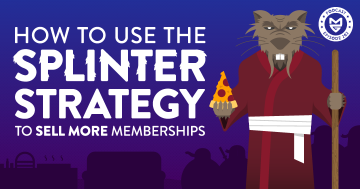There's always an element of risk for prospective members when they consider joining your site…
How will they know if it's the right fit for them?
The truth is they won't until they login and take a look around.
But what if there was a way to give them some extra protection that might incentivize them to press that ‘buy' button and find out for themselves?
Money-back guarantees can do that…
They’re a simple and effective feature you can add to your membership that will work in favor of both you and your members.
Here's how…
Money-back guarantees: The basics
A money-back guarantee is a policy that states that if for some reason a member isn't satisfied after joining your membership, they can get a full refund if they contact you within a set time period (e.g. 30 days).
The main reason money-back guarantees are so prevalent and useful is that they tap into what Jay Abrahams calls “Risk Reversal”…
Meaning you can prove that your membership delivers on your promises without any risk to the end user.
So when someone is deciding to make a purchase and commit their time and money towards something, they typically have dozens of questions they’re trying to answer, like:
- Is this person for real?
- Are my credit card details safe?
- Is this person going to deliver?
- Is it worth it?
It's your job through your marketing and sales techniques to answer those questions, overcome any objections…
And eliminate as many potential problems as possible that may be preventing them from purchasing…
Risk reversal is a great way of doing that.
You can do this by offering things like membership trials and making sure your site is secure…
But one of the best ways of reversing risk is by having a money-back policy…
Especially if you don’t already have an established reputation in your market where you've built up trust before purchase.
A money-back guarantee can alleviate the concerns potential buyers have and shows confidence in your product.
You’re essentially saying:
‘We know that our product is so good that you’re not going to regret buying it, but if you do, we’re confident enough that we’ll give you your money-back.’
Your confidence in your product can and will inspire similar confidence in others.
So now we’re clear on this, let's tackle some common questions we get asked on money-back guarantees…
How long should my money-back guarantee last?
30 days is the standard limit for money-back guarantees and that works for most people…
But in some fields – especially where there's a strong competitive market – 30-day guarantees are the standard.
Sometimes they’re so standard, in fact, that it might not be enough of a convincing feature.
With this in mind, if you can extend your guarantee further, you should…
Doing this will catch people’s eyes and reinvigorate those risk reversal benefits that have been watered down by the broadness of the market.
So if everyone else in your market is offering a 30-day guarantee but yours is 45-days, you stand out with your confidence and trust.
Should I have special conditions and caveats to my money-back guarantee?
We're big fans of keeping it simple…
And firmly believe that you don’t need to put any special conditions or caveats in place…
Because as soon as you do, you’re setting yourself up for future conflict and potential payment disputes in your membership.
Even though you might only want to offer refunds to people who have made a genuine effort to explore your membership…
The time you'll lose by trying to enforce your conditions will not be worth it.
You’ll end up spending hours trying to enforce the asterisks and caveats of your policy just to prevent someone getting their first month’s membership fee back.
And if you’re paying yourself an appropriate rate, it’s simply not going to be worth your time in financial terms.
Just as an example, I saw a course being offered the other day with a 30-day guarantee, but the course itself was being drip-fed over 6 months.
As a course model, that’s fine…
But the conditions of the guarantee were that you had to demonstrate that you had consumed the entire course to be eligible.
In other words, you had to complete the 6-month course if you wanted to enact the 30-day money-back guarantee.
Conditions like this produce the opposite effective that a good money-back guarantee should produce.
That's not risk reversal – it's just an example of questionable business practice!
Should I offer a money-back guarantee as well as a trial period?
If your trial is shorter than your money-back guarantee period (e.g. you run a 14-day trial and have a 30-day guarantee), then go for it and offer both…
After all, you'll be doubling up on that risk reversal.
If, however, you’re offering a 30-day trial and 30-day guarantee, then the two features become redundant and one cancels the other out.
This is also a good point to reflect on whether you want to offer your money-back guarantee from the date somebody signs up…
Or from the date they make their first payment.
This can influence how your trial period and guarantee period interact.
Whatever you decide, the key is that you are clear in communicating your guarantee.
A good rule we always try to stick to is that, if we're finding ourselves struggling to communicate the terms, then we are probably heading down the wrong path.
So at this stage, you're probably starting to notice a pattern in our thinking when it comes to money-back guarantees…
And that's simplicity….
This basically boils down to the fact that you don’t want to make things harder for yourself.
Where possible follow the KISS principle…
Keep It Super Simple (We've tweaked that acronym a bit as we'd prefer not to call you stupid!)
Have as few conditions as possible, no hoops to jump through and no ‘gotchas’ within your money-back guarantee.
There are some situations where it’s necessary to have conditions and clauses…
For example, to prevent people signing up, leaving, and re-joining on a cycle every few months.
They shouldn't be entitled to the money-back guarantee after the first time…
But again, keep it as clear and simple as possible.
Putting it into perspective…
You might be thinking that you still really don’t want to offer a money-back guarantee because you don’t want to encourage people to ‘dine and dash’…
Meaning people join, get everything they’re after, and then leave without having paid for it.
That fear is understandable, but if we look at it a little closer, it doesn’t stand up to reason.
This happens way, way less often than you think.
As is often the case with memberships, we tend to worry more about the unscrupulous tiny minority, rather than the interested and awesome vast majority.
99.99% of your members are awesome and want you to succeed as much as they want to succeed themselves.
Anyone who truly wants to rip you off will find a way to do it regardless of whether you have a trial or a money-back guarantee.
If these people are the main reason you’re avoiding trials, money-back guarantees, and refund policies…
Just keep in mind that your time is better spent pleasing the 99 members out of 100 who are awesome.
Thank You For Listening
We really appreciate you chosing to listen to us and for supporting the podcast. If you enjoyed today's show, please share it using the social media buttons on this page.
We would also be eternally grateful if you would consider taking a minute or two to leave an honest review and rating for the show in iTunes. They're extremely helpful when it comes to reaching our audience and we read each and every one personally!
Finally, don't forget to subscribe to the podcast in iTunes to make sure that you never miss an episode





